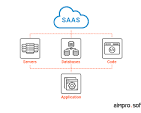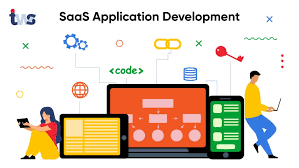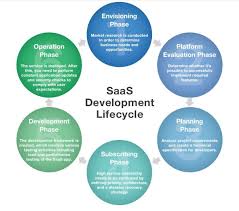Unlocking Efficiency: The Power of SaaS Applications
The Power of SaaS Applications
Software as a Service (SaaS) applications have revolutionized the way businesses operate in the digital age. Unlike traditional software models that require installation and maintenance on individual devices, SaaS applications are hosted in the cloud and accessed through the internet.
One of the key advantages of SaaS applications is their accessibility. Users can access the software from any device with an internet connection, making it convenient for remote work and collaboration. This flexibility allows teams to work together seamlessly, regardless of their physical location.
Another benefit of SaaS applications is scalability. Businesses can easily adjust their subscription plans based on their needs, whether they need to add more users or upgrade to a higher tier for additional features. This scalability makes SaaS applications cost-effective for businesses of all sizes.
Security is a top priority for SaaS providers. With data stored in secure cloud environments and regular updates to address vulnerabilities, businesses can trust that their sensitive information is protected. This peace of mind allows organizations to focus on their core operations without worrying about data breaches or cyber threats.
SaaS applications also offer automatic updates and maintenance, eliminating the need for manual installations and upgrades. This ensures that users always have access to the latest features and improvements without any additional effort on their part.
In conclusion, SaaS applications have transformed the way businesses leverage technology to streamline operations, enhance collaboration, and drive growth. With their accessibility, scalability, security, and convenience, SaaS applications are a valuable asset for modern organizations looking to stay competitive in today’s fast-paced digital landscape.
8 Essential Tips for Building a Successful SaaS Application
- Ensure data security and privacy measures are robust.
- Provide regular software updates to enhance performance and security.
- Offer a user-friendly interface for easy navigation and adoption.
- Implement effective customer support channels for prompt assistance.
- Integrate analytics tools to track usage and gather insights for improvements.
- Enable seamless scalability to accommodate growing business needs.
- Define clear service level agreements (SLAs) to manage expectations.
- Regularly gather feedback from users to drive continuous improvement.
Ensure data security and privacy measures are robust.
When utilizing a Software as a Service (SaaS) application, it is crucial to ensure that data security and privacy measures are robust. Protecting sensitive information is paramount in today’s digital landscape, and implementing strong security protocols within the SaaS platform helps safeguard against potential threats and unauthorized access. By prioritizing data security and privacy, businesses can instill trust among users, maintain compliance with regulations, and mitigate the risks associated with cyber threats. Vigilance in maintaining robust security measures is essential for fostering a secure and reliable environment for data storage and processing within SaaS applications.
Provide regular software updates to enhance performance and security.
Regular software updates play a crucial role in optimizing the performance and security of SaaS applications. By providing timely updates, businesses can ensure that their software remains efficient, reliable, and protected against potential vulnerabilities. These updates not only enhance the user experience by introducing new features and improvements but also reinforce the overall security posture of the application. By staying proactive with software updates, organizations can mitigate risks, maintain compliance with industry standards, and demonstrate a commitment to delivering a high-quality product to their users.
Offer a user-friendly interface for easy navigation and adoption.
When developing a Software as a Service (SaaS) application, it is crucial to prioritize offering a user-friendly interface for easy navigation and adoption. A well-designed interface not only enhances the user experience but also accelerates the onboarding process for new users. By focusing on intuitive design elements, clear navigation pathways, and accessible features, SaaS providers can ensure that users can quickly familiarize themselves with the application and maximize its functionality efficiently. This approach promotes user satisfaction, boosts productivity, and ultimately contributes to the overall success of the SaaS application in meeting the needs of its users.
Implement effective customer support channels for prompt assistance.
To maximize the benefits of a SaaS application, it is crucial to implement effective customer support channels for prompt assistance. By providing users with easy access to knowledgeable support staff through various communication channels such as live chat, email, and phone support, businesses can ensure that any issues or queries are addressed promptly. This proactive approach not only enhances user experience but also builds trust and loyalty among customers, ultimately leading to increased satisfaction and retention rates. Effective customer support channels play a vital role in ensuring a smooth and successful user experience with SaaS applications.
Integrate analytics tools to track usage and gather insights for improvements.
By integrating analytics tools into your SaaS application, you can track user behavior, monitor usage patterns, and gather valuable insights to drive improvements. Analyzing data such as user engagement, feature adoption rates, and performance metrics allows you to make informed decisions on enhancing the user experience, optimizing functionalities, and identifying areas for growth. Leveraging analytics tools empowers you to continuously refine your SaaS application based on real-time data, ensuring that it remains relevant and valuable to your users.
Enable seamless scalability to accommodate growing business needs.
To maximize the benefits of a SaaS application, it is crucial to enable seamless scalability to accommodate growing business needs. By ensuring that the software can easily expand to meet increased demands, businesses can adapt to changing requirements without disruption. This flexibility allows organizations to scale their operations efficiently, add new users or features as needed, and stay agile in a dynamic business environment. Embracing seamless scalability in a SaaS application empowers businesses to grow sustainably and optimize their resources for long-term success.
Define clear service level agreements (SLAs) to manage expectations.
When implementing a Software as a Service (SaaS) application, it is crucial to define clear service level agreements (SLAs) to manage expectations effectively. SLAs outline the level of service that users can expect from the SaaS provider, including performance metrics, availability guarantees, and support response times. By establishing transparent SLAs, both parties have a mutual understanding of responsibilities and commitments, ensuring a smooth and reliable user experience. Clear SLAs help manage expectations, build trust between the provider and users, and provide a framework for resolving any issues that may arise during the use of the SaaS application.
Regularly gather feedback from users to drive continuous improvement.
Regularly gathering feedback from users is a crucial practice when it comes to optimizing SaaS applications. By listening to user input and understanding their needs and challenges, businesses can drive continuous improvement and ensure that the software meets evolving requirements. User feedback provides valuable insights that can guide developers in enhancing features, addressing usability issues, and prioritizing updates. This iterative process of feedback collection and implementation not only fosters user satisfaction but also helps SaaS providers stay competitive in the ever-changing tech landscape.





